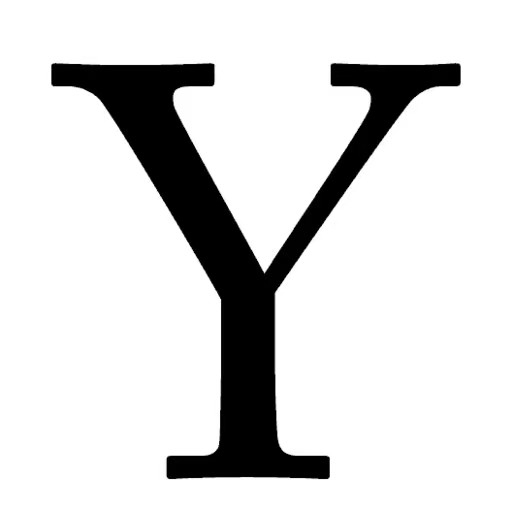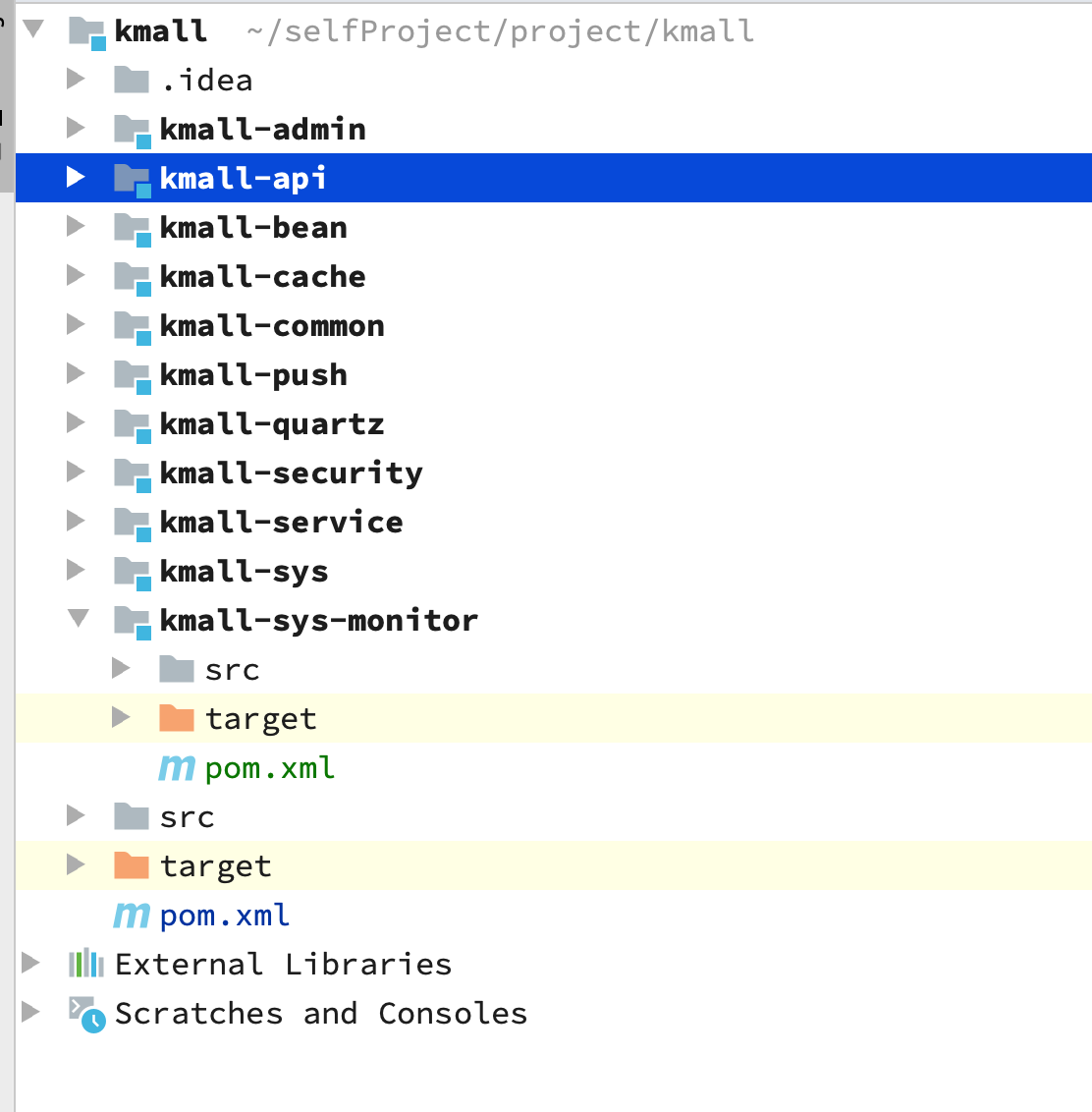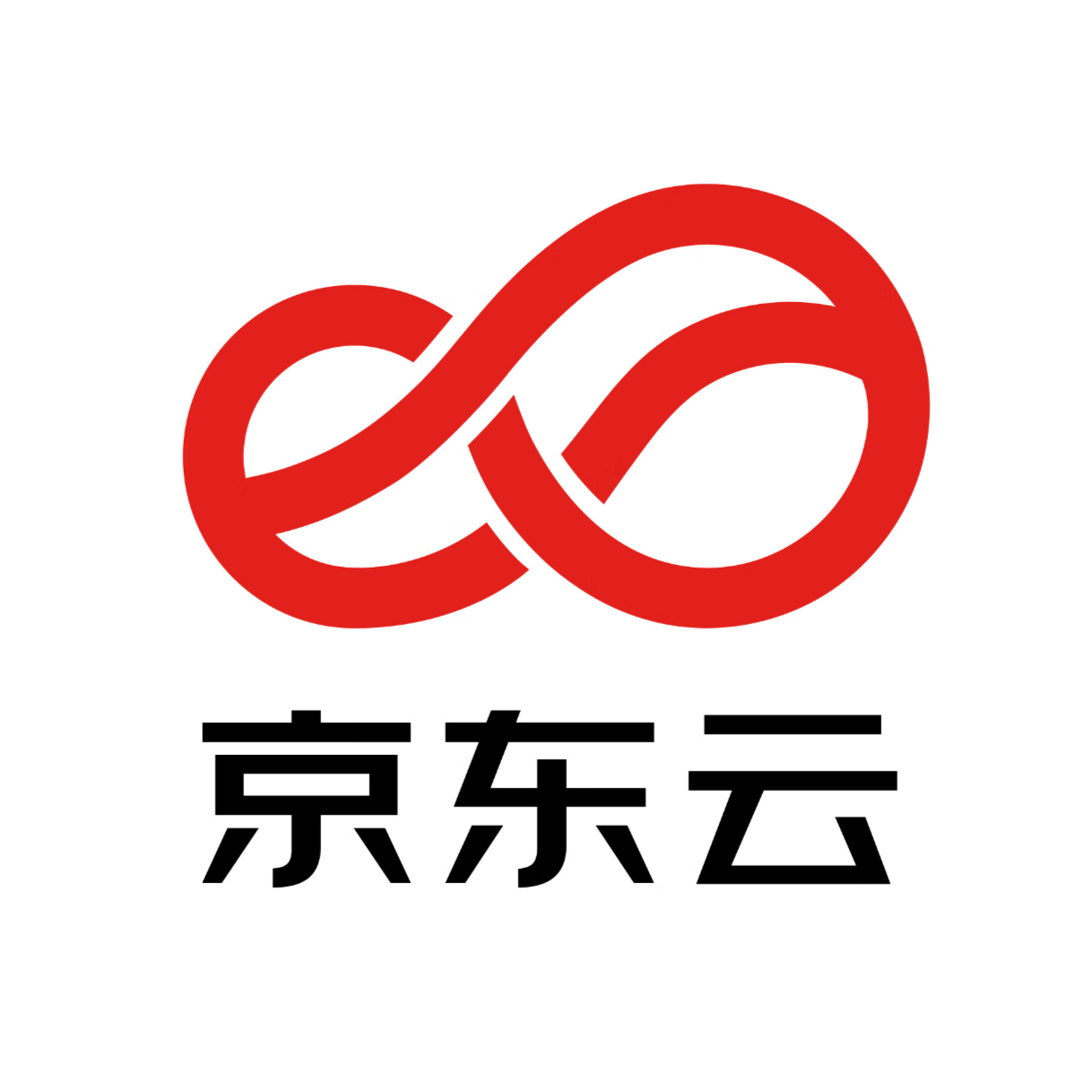
前言
我们知道SpringBoot给我们带来了一个全新的开发体验,我们可以直接把web程序达成jar包,直接启动,这就得益于SpringBoot内置了容器,可以直接启动,本文将以Tomcat为例,来看看SpringBoot是如何启动Tomcat的,同时也将展开学习下Tomcat的源码,了解Tomcat的设计。
从 Main 方法说起
用过SpringBoot的人都知道,首先要写一个main方法来启动
@SpringBootApplication
public class TomcatdebugApplication {
public static void main(String[] args) {
SpringApplication.run(TomcatdebugApplication.class, args);
}
}
我们直接点击run方法的源码,跟踪下来,发下最终 的run方法是调用ConfigurableApplicationContext方法,源码如下:
public ConfigurableApplicationContext run(String... args) {
StopWatch stopWatch = new StopWatch();
stopWatch.start();
ConfigurableApplicationContext context = null;
Collection<springbootexceptionreporter> exceptionReporters = new ArrayList<>();
//设置系统属性『java.awt.headless』,为true则启用headless模式支持
configureHeadlessProperty();
//通过*SpringFactoriesLoader*检索*META-INF/spring.factories*,
//找到声明的所有SpringApplicationRunListener的实现类并将其实例化,
//之后逐个调用其started()方法,广播SpringBoot要开始执行了
SpringApplicationRunListeners listeners = getRunListeners(args);
//发布应用开始启动事件
listeners.starting();
try {
//初始化参数
ApplicationArguments applicationArguments = new DefaultApplicationArguments(args);
//创建并配置当前SpringBoot应用将要使用的Environment(包括配置要使用的PropertySource以及Profile),
//并遍历调用所有的SpringApplicationRunListener的environmentPrepared()方法,广播Environment准备完毕。
ConfigurableEnvironment environment = prepareEnvironment(listeners, applicationArguments);
configureIgnoreBeanInfo(environment);
//打印banner
Banner printedBanner = printBanner(environment);
//创建应用上下文
context = createApplicationContext();
//通过*SpringFactoriesLoader*检索*META-INF/spring.factories*,获取并实例化异常分析器
exceptionReporters = getSpringFactoriesInstances(SpringBootExceptionReporter.class,
new Class[] { ConfigurableApplicationContext.class }, context);
//为ApplicationContext加载environment,之后逐个执行ApplicationContextInitializer的initialize()方法来进一步封装ApplicationContext,
//并调用所有的SpringApplicationRunListener的contextPrepared()方法,【EventPublishingRunListener只提供了一个空的contextPrepared()方法】,
//之后初始化IoC容器,并调用SpringApplicationRunListener的contextLoaded()方法,广播ApplicationContext的IoC加载完成,
//这里就包括通过**@EnableAutoConfiguration**导入的各种自动配置类。
prepareContext(context, environment, listeners, applicationArguments, printedBanner);
//刷新上下文
refreshContext(context);
//再一次刷新上下文,其实是空方法,可能是为了后续扩展。
afterRefresh(context, applicationArguments);
stopWatch.stop();
if (this.logStartupInfo) {
new StartupInfoLogger(this.mainApplicationClass).logStarted(getApplicationLog(), stopWatch);
}
//发布应用已经启动的事件
listeners.started(context);
//遍历所有注册的ApplicationRunner和CommandLineRunner,并执行其run()方法。
//我们可以实现自己的ApplicationRunner或者CommandLineRunner,来对SpringBoot的启动过程进行扩展。
callRunners(context, applicationArguments);
}
catch (Throwable ex) {
handleRunFailure(context, ex, exceptionReporters, listeners);
throw new IllegalStateException(ex);
}
try {
//应用已经启动完成的监听事件
listeners.running(context);
}
catch (Throwable ex) {
handleRunFailure(context, ex, exceptionReporters, null);
throw new IllegalStateException(ex);
}
return context;
}
其实这个方法我们可以简单的总结下步骤为 > 1. 配置属性 > 2. 获取监听器,发布应用开始启动事件 > 3. 初始化输入参数 > 4. 配置环境,输出banner > 5. 创建上下文 > 6. 预处理上下文 > 7. 刷新上下文 > 8. 再刷新上下文 > 9. 发布应用已经启动事件 > 10. 发布应用启动完成事件
其实上面这段代码,如果只要分析tomcat内容的话,只需要关注两个内容即可,上下文是如何创建的,上下文是如何刷新的,分别对应的方法就是createApplicationContext() 和refreshContext(context),接下来我们来看看这两个方法做了什么。
protected ConfigurableApplicationContext createApplicationContext() {
Class<!--?--> contextClass = this.applicationContextClass;
if (contextClass == null) {
try {
switch (this.webApplicationType) {
case SERVLET:
contextClass = Class.forName(DEFAULT_SERVLET_WEB_CONTEXT_CLASS);
break;
case REACTIVE:
contextClass = Class.forName(DEFAULT_REACTIVE_WEB_CONTEXT_CLASS);
break;
default:
contextClass = Class.forName(DEFAULT_CONTEXT_CLASS);
}
}
catch (ClassNotFoundException ex) {
throw new IllegalStateException(
"Unable create a default ApplicationContext, " + "please specify an ApplicationContextClass",
ex);
}
}
return (ConfigurableApplicationContext) BeanUtils.instantiateClass(contextClass);
}
这里就是根据我们的webApplicationType 来判断创建哪种类型的Servlet,代码中分别对应着Web类型(SERVLET),响应式Web类型(REACTIVE),非Web类型(default),我们建立的是Web类型,所以肯定实例化 DEFAULT_SERVLET_WEB_CONTEXT_CLASS指定的类,也就是AnnotationConfigServletWebServerApplicationContext类,我们来用图来说明下这个类的关系
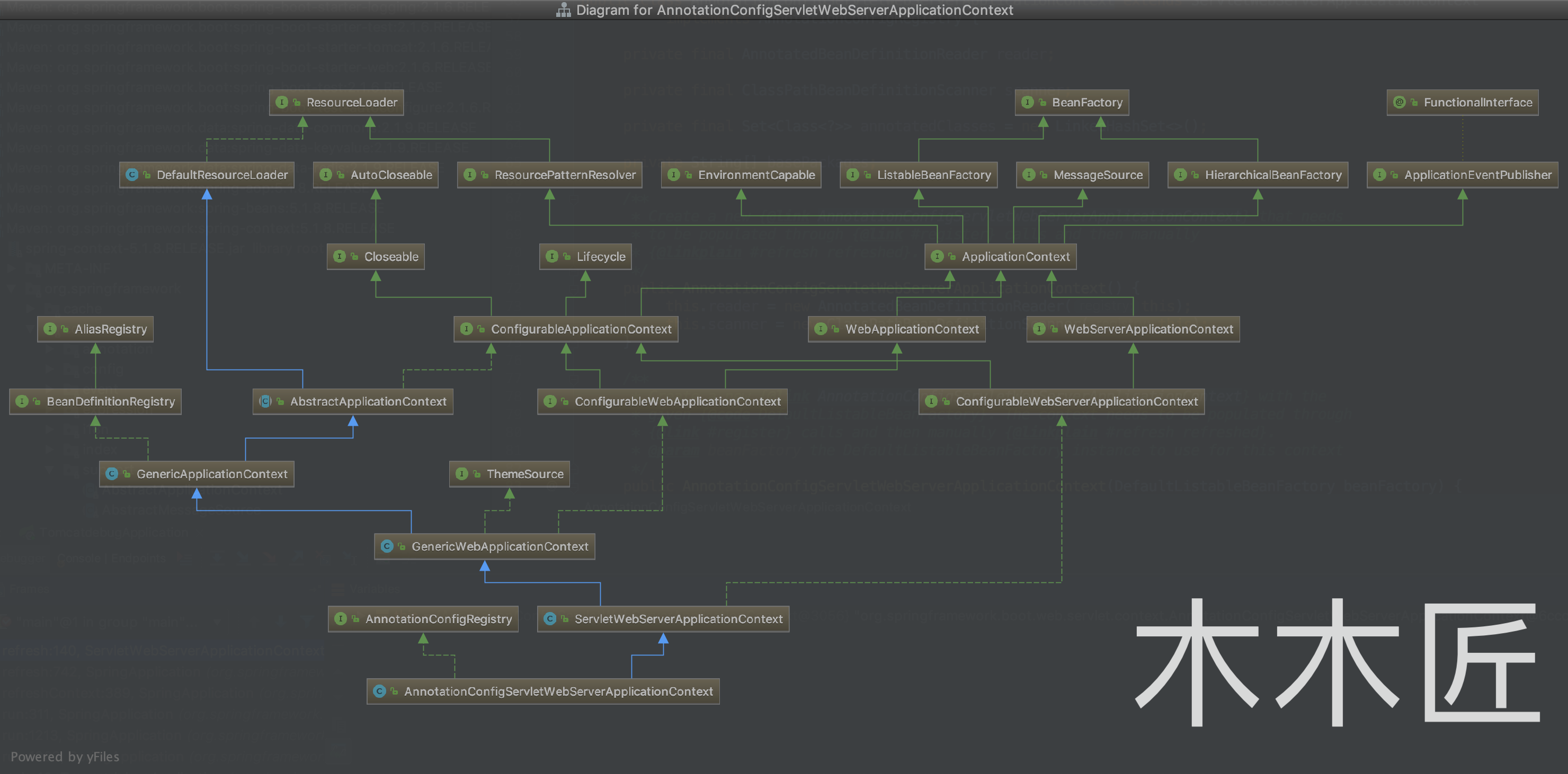
通过这个类图我们可以知道,这个类继承的是ServletWebServerApplicationContext,这就是我们真正的主角,而这个类最终是继承了AbstractApplicationContext,了解完创建上下文的情况后,我们再来看看刷新上下文,相关代码如下:
//类:SpringApplication.java
private void refreshContext(ConfigurableApplicationContext context) {
//直接调用刷新方法
refresh(context);
if (this.registerShutdownHook) {
try {
context.registerShutdownHook();
}
catch (AccessControlException ex) {
// Not allowed in some environments.
}
}
}
//类:SpringApplication.java
protected void refresh(ApplicationContext applicationContext) {
Assert.isInstanceOf(AbstractApplicationContext.class, applicationContext);
((AbstractApplicationContext) applicationContext).refresh();
}
这里还是直接传递调用本类的refresh(context)方法,最后是强转成父类AbstractApplicationContext调用其refresh()方法,该代码如下:
// 类:AbstractApplicationContext
public void refresh() throws BeansException, IllegalStateException {
synchronized (this.startupShutdownMonitor) {
// Prepare this context for refreshing.
prepareRefresh();
// Tell the subclass to refresh the internal bean factory.
ConfigurableListableBeanFactory beanFactory = obtainFreshBeanFactory();
// Prepare the bean factory for use in this context.
prepareBeanFactory(beanFactory);
try {
// Allows post-processing of the bean factory in context subclasses.
postProcessBeanFactory(beanFactory);
// Invoke factory processors registered as beans in the context.
invokeBeanFactoryPostProcessors(beanFactory);
// Register bean processors that intercept bean creation.
registerBeanPostProcessors(beanFactory);
// Initialize message source for this context.
initMessageSource();
// Initialize event multicaster for this context.
initApplicationEventMulticaster();
// Initialize other special beans in specific context subclasses.这里的意思就是调用各个子类的onRefresh()
onRefresh();
// Check for listener beans and register them.
registerListeners();
// Instantiate all remaining (non-lazy-init) singletons.
finishBeanFactoryInitialization(beanFactory);
// Last step: publish corresponding event.
finishRefresh();
}
catch (BeansException ex) {
if (logger.isWarnEnabled()) {
logger.warn("Exception encountered during context initialization - " +
"cancelling refresh attempt: " + ex);
}
// Destroy already created singletons to avoid dangling resources.
destroyBeans();
// Reset 'active' flag.
cancelRefresh(ex);
// Propagate exception to caller.
throw ex;
}
finally {
// Reset common introspection caches in Spring's core, since we
// might not ever need metadata for singleton beans anymore...
resetCommonCaches();
}
}
}
这里我们看到onRefresh()方法是调用其子类的实现,根据我们上文的分析,我们这里的子类是ServletWebServerApplicationContext。
//类:ServletWebServerApplicationContext
protected void onRefresh() {
super.onRefresh();
try {
createWebServer();
}
catch (Throwable ex) {
throw new ApplicationContextException("Unable to start web server", ex);
}
}
private void createWebServer() {
WebServer webServer = this.webServer;
ServletContext servletContext = getServletContext();
if (webServer == null && servletContext == null) {
ServletWebServerFactory factory = getWebServerFactory();
this.webServer = factory.getWebServer(getSelfInitializer());
}
else if (servletContext != null) {
try {
getSelfInitializer().onStartup(servletContext);
}
catch (ServletException ex) {
throw new ApplicationContextException("Cannot initialize servlet context", ex);
}
}
initPropertySources();
}
到这里,其实庐山真面目已经出来了,createWebServer()就是启动web服务,但是还没有真正启动Tomcat,既然webServer是通过ServletWebServerFactory来获取的,我们就来看看这个工厂的真面目。
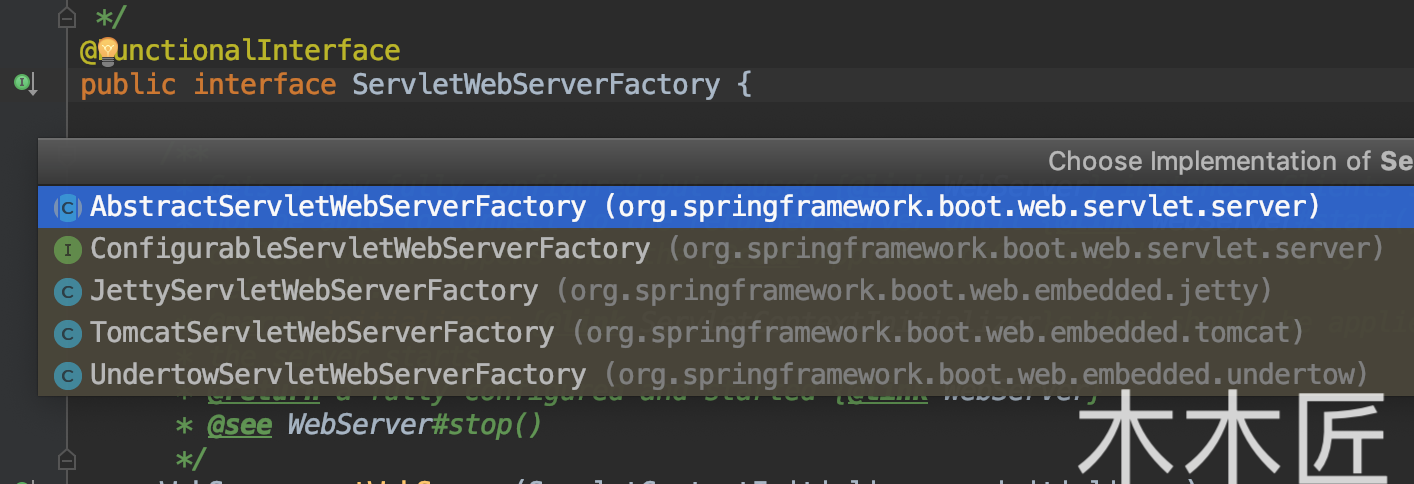
走进Tomcat内部
根据上图我们发现,工厂类是一个接口,各个具体服务的实现是由各个子类来实现的,所以我们就去看看TomcatServletWebServerFactory.getWebServer()的实现。
@Override
public WebServer getWebServer(ServletContextInitializer... initializers) {
Tomcat tomcat = new Tomcat();
File baseDir = (this.baseDirectory != null) ? this.baseDirectory : createTempDir("tomcat");
tomcat.setBaseDir(baseDir.getAbsolutePath());
Connector connector = new Connector(this.protocol);
tomcat.getService().addConnector(connector);
customizeConnector(connector);
tomcat.setConnector(connector);
tomcat.getHost().setAutoDeploy(false);
configureEngine(tomcat.getEngine());
for (Connector additionalConnector : this.additionalTomcatConnectors) {
tomcat.getService().addConnector(additionalConnector);
}
prepareContext(tomcat.getHost(), initializers);
return getTomcatWebServer(tomcat);
}
根据上面的代码,我们发现其主要做了两件事情,第一件事就是把Connnctor(我们称之为连接器)对象添加到Tomcat中,第二件事就是configureEngine,这连接器我们勉强能理解(不理解后面会述说),那这个Engine是什么呢?我们查看tomcat.getEngine()的源码:
public Engine getEngine() {
Service service = getServer().findServices()[0];
if (service.getContainer() != null) {
return service.getContainer();
}
Engine engine = new StandardEngine();
engine.setName( "Tomcat" );
engine.setDefaultHost(hostname);
engine.setRealm(createDefaultRealm());
service.setContainer(engine);
return engine;
}
根据上面的源码,我们发现,原来这个Engine是容器,我们继续跟踪源码,找到Container接口
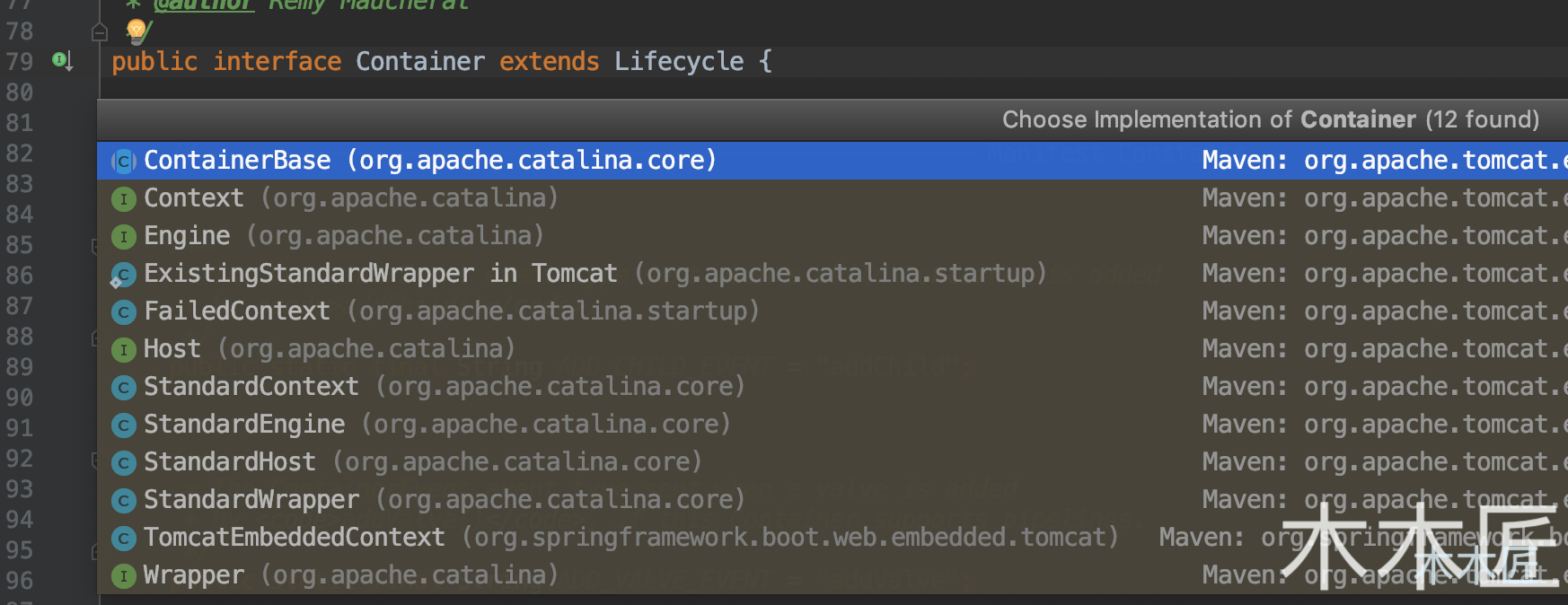
上图中,我们看到了4个子接口,分别是Engine,Host,Context,Wrapper。我们从继承关系上可以知道他们都是容器,那么他们到底有啥区别呢?我看看他们的注释是怎么说的。
/**
If used, an Engine is always the top level Container in a Catalina
* hierarchy. Therefore, the implementation's <code>setParent()</code> method
* should throw <code>IllegalArgumentException</code>.
*
* @author Craig R. McClanahan
*/
public interface Engine extends Container {
//省略代码
}
/**
* <p>
* The parent Container attached to a Host is generally an Engine, but may
* be some other implementation, or may be omitted if it is not necessary.
* </p><p>
* The child containers attached to a Host are generally implementations
* of Context (representing an individual servlet context).
*
* @author Craig R. McClanahan
*/
public interface Host extends Container {
//省略代码
}
/*** </p><p>
* The parent Container attached to a Context is generally a Host, but may
* be some other implementation, or may be omitted if it is not necessary.
* </p><p>
* The child containers attached to a Context are generally implementations
* of Wrapper (representing individual servlet definitions).
* </p><p>
*
* @author Craig R. McClanahan
*/
public interface Context extends Container, ContextBind {
//省略代码
}
/**</p><p>
* The parent Container attached to a Wrapper will generally be an
* implementation of Context, representing the servlet context (and
* therefore the web application) within which this servlet executes.
* </p><p>
* Child Containers are not allowed on Wrapper implementations, so the
* <code>addChild()</code> method should throw an
* <code>IllegalArgumentException</code>.
*
* @author Craig R. McClanahan
*/
public interface Wrapper extends Container {
//省略代码
}
上面的注释翻译过来就是,Engine是最高级别的容器,其子容器是Host,Host的子容器是Context,Wrapper是Context的子容器,所以这4个容器的关系就是父子关系,也就是Engine>Host>Context>Wrapper。 我们再看看Tomcat类的源码:
//部分源码,其余部分省略。
public class Tomcat {
//设置连接器
public void setConnector(Connector connector) {
Service service = getService();
boolean found = false;
for (Connector serviceConnector : service.findConnectors()) {
if (connector == serviceConnector) {
found = true;
}
}
if (!found) {
service.addConnector(connector);
}
}
//获取service
public Service getService() {
return getServer().findServices()[0];
}
//设置Host容器
public void setHost(Host host) {
Engine engine = getEngine();
boolean found = false;
for (Container engineHost : engine.findChildren()) {
if (engineHost == host) {
found = true;
}
}
if (!found) {
engine.addChild(host);
}
}
//获取Engine容器
public Engine getEngine() {
Service service = getServer().findServices()[0];
if (service.getContainer() != null) {
return service.getContainer();
}
Engine engine = new StandardEngine();
engine.setName( "Tomcat" );
engine.setDefaultHost(hostname);
engine.setRealm(createDefaultRealm());
service.setContainer(engine);
return engine;
}
//获取server
public Server getServer() {
if (server != null) {
return server;
}
System.setProperty("catalina.useNaming", "false");
server = new StandardServer();
initBaseDir();
// Set configuration source
ConfigFileLoader.setSource(new CatalinaBaseConfigurationSource(new File(basedir), null));
server.setPort( -1 );
Service service = new StandardService();
service.setName("Tomcat");
server.addService(service);
return server;
}
//添加Context容器
public Context addContext(Host host, String contextPath, String contextName,
String dir) {
silence(host, contextName);
Context ctx = createContext(host, contextPath);
ctx.setName(contextName);
ctx.setPath(contextPath);
ctx.setDocBase(dir);
ctx.addLifecycleListener(new FixContextListener());
if (host == null) {
getHost().addChild(ctx);
} else {
host.addChild(ctx);
}
//添加Wrapper容器
public static Wrapper addServlet(Context ctx,
String servletName,
Servlet servlet) {
// will do class for name and set init params
Wrapper sw = new ExistingStandardWrapper(servlet);
sw.setName(servletName);
ctx.addChild(sw);
return sw;
}
}
阅读Tomcat的getServer()我们可以知道,Tomcat的最顶层是Server,Server就是Tomcat的实例,一个Tomcat一个Server;通过getEngine()我们可以了解到Server下面是Service,而且是多个,一个Service代表我们部署的一个应用,而且我们还可以知道,Engine容器,一个service只有一个;根据父子关系,我们看setHost()源码可以知道,host容器有多个;同理,我们发现addContext()源码下,Context也是多个;addServlet()表明Wrapper容器也是多个,而且这段代码也暗示了,其实Wrapper和Servlet是一层意思。另外我们根据setConnector源码可以知道,连接器(Connector)是设置在service下的,而且是可以设置多个连接器(Connector)。
根据上面分析,我们可以小结下: Tomcat主要包含了2个核心组件,连接器(Connector)和容器(Container),用图表示如下:
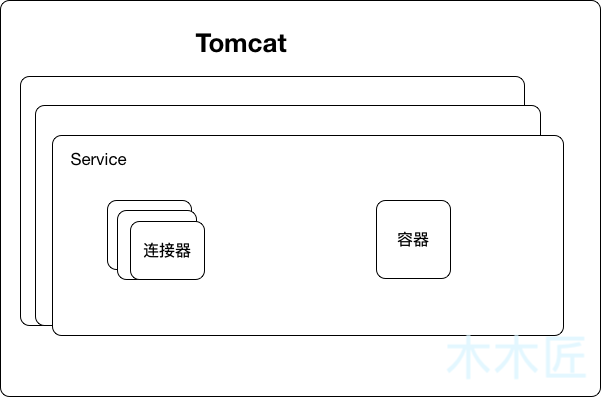
一个Tomcat是一个Server,一个Server下有多个service,也就是我们部署的多个应用,一个应用下有多个连接器(Connector)和一个容器(Container),容器下有多个子容器,关系用图表示如下:
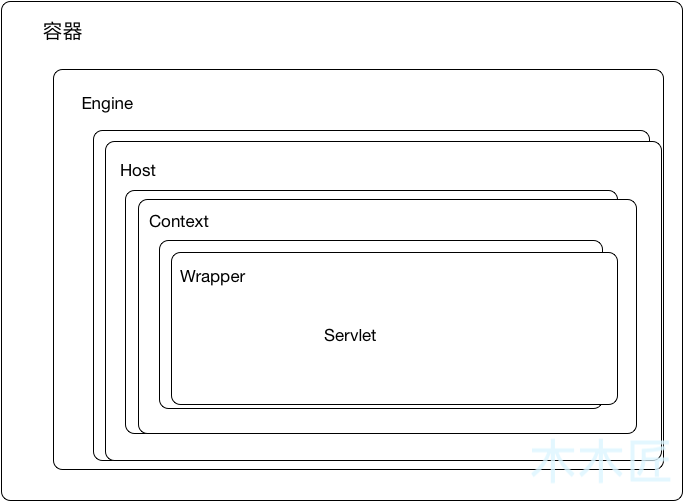
Engine下有多个Host子容器,Host下有多个Context子容器,Context下有多个Wrapper子容器。
总结
SpringBoot的启动是通过new SpringApplication()实例来启动的,启动过程主要做如下几件事情: > 1. 配置属性 > 2. 获取监听器,发布应用开始启动事件 > 3. 初始化输入参数 > 4. 配置环境,输出banner > 5. 创建上下文 > 6. 预处理上下文 > 7. 刷新上下文 > 8. 再刷新上下文 > 9. 发布应用已经启动事件 > 10. 发布应用启动完成事件
而启动Tomcat就是在第7步中“刷新上下文”;Tomcat的启动主要是初始化2个核心组件,连接器(Connector)和容器(Container),一个Tomcat实例就是一个Server,一个Server包含多个Service,也就是多个应用程序,每个Service包含多个连接器(Connetor)和一个容器(Container),而容器下又有多个子容器,按照父子关系分别为:Engine,Host,Context,Wrapper,其中除了Engine外,其余的容器都是可以有多个。
下期展望
本期文章通过SpringBoot的启动来窥探了Tomcat的内部结构,下一期,我们来分析下本次文章中的连接器(Connetor)和容器(Container)的作用,敬请期待。
版权声明:原创文章,转载请注明出处。









